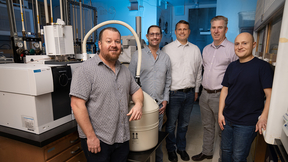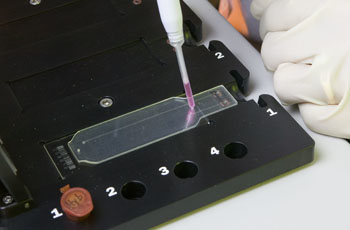Lab technologies answer nation's call to prevent bioterrorism
In trying to protect the nation against bioterrorism, national lab and university scientists, public health authorities and law enforcement agencies have waged the fight on many fronts.
Their efforts have included technologies to rapidly detect a pathogen once it is released, antidotes and medical countermeasures for people exposed to the pathogen, the capacity to process samples with possible bioterrorist agents, technologies and standards for cleaning contaminated facilities, and the preparation of authoritative analyses to understand potential threats.
Scientists and engineers from LLNL have worked in all of these areas, and more, in the decade since 9/11 as they have worked with their researchers at other institutions to better protect the United States.
A more rapid warning system
In 1997, years before the attacks of Sept. 11, 2001, Lab scientists and engineers received seed funding from the Laboratory Directed Research and Development Program to develop an automated instrument that would provide a rapid warning system for pathogens, such as anthrax and plague.
That system, known as the Autonomous Pathogen Detection System, or APDS, is the Laboratory's next-generation biological detection system and has been licensed to Northrop Grumman Corp. It won an R&D 100 award in 2004.
The lectern-size APDS can be placed in airports, office buildings, auditoriums, mass transit systems, sports arenas - or anywhere an attack might be launched.
The system, which can run unattended for up to a week and can report any pathogen releases in its vicinity to a central location, can monitor the air for the three types of biological threat agents: bacteria, viruses and toxins.
APDS collects aerosol samples, prepares them for analysis and tests for multiple biological agents simultaneously. This automation reduces the cost and staffing that would be required to manually analyze samples.
The system is currently under evaluation to enable the country to deploy the next-generation BioWatch system to detect and characterize bioterrorist attacks. The objectives of the next-generation system are to deploy 2,600 autonomous instruments in about 50 jurisdictions, monitor 160 select high-risk facilities and decrease the time to detection to four hours.
APDS can simultaneously monitor up to 100 biological signals at a time.
The APDS technology has reached a high level of operational maturity that has been continuously improved through a series of tests at the Albuquerque Airport in New Mexico, in San Diego, at a Washington, D.C. Metro station and in New York City, where the deployment lasted for 15 months.
Testing for a broader spectrum of pathogens
Many of today's biological detection systems can monitor for a set number of prioritized high-risk pathogens.
However, a newer Livermore technology called the Lawrence Livermore Microbial Detection Array (LLMDA), contains probes that can detect more than 2,000 viruses and about 900 bacteria within 24 hours.
"We continue to look at technologies like the microarrays to address the evolving and advanced biological threats," Rakestraw said.
"Currently, the BioWatch system looks for a fixed number of threats. In the future, the threat space will be much larger and require us to look at hundreds or thousands of potential signatures for detection," he added.
Developed between October 2007 and February 2008, the LLMDA detects viruses and bacteria with the use of 388,000 probes that fit in a checkerboard pattern in the middle of a one-inch wide, three-inch long glass slide.
The LLMDA could enable law enforcement agencies seeking to detect bioterrorist pathogens, medical professionals diagnosing diseases, and regulatory agencies checking product safety, to detect within 24 hours any virus or bacteria that has been sequenced and included among the array's probes.
"The ability to detect the major bacterial and viral components of any sample can be used in countless different ways," said LLNL's Associate Program Leader for Informatics Tom Slezak, who came up with the idea for the LLMDA and whose team has developed it. "This is important because it fills a cost-performance gap that is relevant to many missions: biodefense, public health and product safety."
Developing drugs to combat bioterrorism
As part of LLNL's Medical Countermeasures Program, Lab researchers are collaborating with industrial partners to design and develop new drug delivery platforms, vaccines and broad-spectrum antimicrobials.
One example is the team's work with Trius Therapeutics, Inc, a San Diego-based biopharmaceutical company, to design and develop a new broad spectrum antibiotic against gram-negative bacteria.
Trius' mission is to discover, develop and commercialize innovative antibiotics for serious, life-threatening infections, which include the infections that would be a result of a bioterrorism attack. LLNL also is designing and developing novel antimicrobials to fight bioterrorism infections.
The National Institute of Allergy and Infectious Disease (NIAID) is funding Trius Therapeutics and LLNL at $27 million for five years to create a new antibacterial compound.
Livermore researchers have used the Lab's high performance computing capabilities to screen new compounds, create detailed maps of the protein target features to be exploited for drug design binding, predict physiochemical properties of the compounds that can lead to potency and efficacy of the compound, and predict any potential for side effects.
In addition, Lab scientists have tested compounds - and found them to be effective -- on biodefense pathogens.
The computational efforts have allowed LLNL researchers to help Trius bring eight compounds forward for testing. Finally, as a part of preclinical development of a drug, LLNL is using the Accelerator Mass Spectrometer technology to measure the pharmacokinetic behavior of the compounds. This highly sensitive and quantitative measurement will allow testing of the compounds in humans as early as possible to determine if the current models are sufficient to predict human safety and efficacy.
A network for processing samples
In 1998, in response to the Gulf War, Congress established the federal Laboratory Response Network (LRN), which included LLNL, to process biological samples. However, the anthrax letters that appeared in the wake of 9/11 overwhelmed the LRN system.
As a result, the Office of Emergency Preparedness was set up within the U.S. Department of Health and Human Services (HHS), and a new response network - the Integrated Consortium of Laboratory Networks - was established in 2005.
A Laboratory employee, Pete Estacio, who worked at HHS on an interagency personnel assignment between 2001 and 2003, was one of the HHS employees who assisted in establishing the new office and network.
The Integrated Consortium of Laboratory Networks, or ICLN, had never been tested and last year, the Department of Homeland Security's (DHS) Science & Technology Directorate asked if LLNL could test it with blinded samples of vaccine strains of anthrax.
LLNL researchers prepared the samples and sent them to the Centers for Disease Control and Prevention and the Wadsworth Institute in New York, which performed quality assurance testing on the samples.
"In order to be realistic, we had to send the samples out in a very short period to be able to test the surge capacity of the ICLN," said Estacio, who was the principal investigator for the effort. "The effort by many at LLNL was extraordinary in the national interest.
"We received top-notch support from biomedical scientists who prepared the samples and from the Lab shipping department, which worked long hours to be able to get the samples out to 130 federal labs across the country."
The vast majority of the labs passed the test on the first round and the remainder succeeded on the second test, Estacio said.
"The results of testing the ICLN supported that there has been a significantly improved readiness in coordination and capability among federal laboratories to respond to any future bioterrorism attacks," he said.
The ICLN samples were prepared by Lab biomedical scientists Kris Montgomery, Julie Avila and Gilda Vanier. Other important assistance to the project came from technical editor Tom Spafford and Bob Garrett of Shipping.
Remediating biological attacks
During the decade before the 2001 anthrax attacks, LLNL researchers focused on the development of novel decontamination technologies, enhanced sampling and detection methods to speed up the timeline of remediation, and recovery activities and issues of "how clean is clean enough" for human health protection, noted Ellen Raber, deputy program director for Counterterrrorism.
This work was initiated because of LLNL's extensive experience in environmental remediation and regulatory compliance.
LLNL and Sandia National Laboratories partnered with the San Francisco Airport to undertake the development of the first remediation guidance document for use in a potential bioterrorist attack at a major airport. This activity began in the late 1990s and continued until the final DHS-Environmental Protection Agency (EPA) guidance document was published in 2008 incorporating many of the lessons learned from the 2001 anthrax cleanups.
This first LLNL-SNL document was issued as a joint DHS/EPA document and represented the current approach to be used for facility decontamination. Many of these same draft procedures were then utilized and/or modified for decontamination of the 2001 anthrax-contaminated government buildings.
In addition, the LLNL team developed a novel decontamination gel that utilized oxone (peroxymonosulfate) as the active ingredient. This gel was found to be effective as a surface treatment for the difficult-to-kill Bacillus anthracis spores. The material can be used directly in aqueous form and has a greater than one year half-life and is less corrosive than the bleach standard.
Additionally, LLNL had just determined the feasibility of a rapid viability PCR-based method for determining "live vs. dead" spores. This is especially important following decontamination, since the gold standard is to culture, which can take anywhere from 24 to 72 hours to determine effectiveness. This method has now been successfully transferred from DHS to the EPA as the end user and is currently undergoing additional evaluation and testing.
Between 2004 and 2011, LLNL, with assistance from other national labs, was funded by DHS to conduct more than 20 workshops and discussion-based, table-top exercises on biological and chemical remediation that drew several thousand people in total. Agencies that participated in these workshops included the DHS, EPA, HHS, the Federal Bureau of Investigation, the Centers for Disease Control and Prevention, the Transportation Security Administration, the departments of Defense and Transportation, state and county governments, the Bay Area Rapid Transit system and the Washington Metro as well as key airport personnel.
These workshops were aimed at transferring the knowledge and technology of remediating facilities, as well as providing airports a chance to exercise the information in the guidance documents so that they would be better prepared in the future should such an event ever happen. The workshops also addressed some of the earlier issues associated with outdoor wide area contamination across an urban area.
Biological threat analyses assist policy-makers
The Biodefense Knowledge Center (BKC) was established by the DHS Science and Technology Directorate in 2004 to serve as a national resource for technical analysis of biodefense topics.
BKC analysts have supported various interagency customers through the publication of dozens of technical reports. These reports have spanned a range of topics, including assessing the feasibility with which emerging technologies could be exploited by an adversary for offensive purposes, to analyses centered directly on acquisition, large-scale production, or dissemination of a biological warfare agent.
Other work involves cooperating closely with DHS Customs and Border Protection to improve the methods used to screen cargo shipments into the United States for potential biological agents, exploitable technologies, or precursor materials. The BKC also has played a key role in supporting the Department of Health and Human Services with information to assist the selection of medical countermeasures for the strategic national stockpile.
For the past three years, the BKC has also made available to the national security community a modern, comprehensive knowledge management system that integrates dozens of interagency data sources and technical reports. The information system houses all the assessments developed by the BKC, as well as millions of other documents that may be useful to analysts, decision-makers and operational groups. The system also is designed to enable discovery and visualization of previously unknown connections among information in the system, further enabling rapid and comprehensive understanding of technical topics and trends.
These are some of the areas and technologies on which LLNL scientists and engineers have worked during the past decade since 9/11 to help the nation be better prepared to combat bioterrorism.
Contact
Stephen P Wampler[email protected]
925-423-3107
Tags
Global SecurityScience
Strategic Deterrence
Featured Articles









